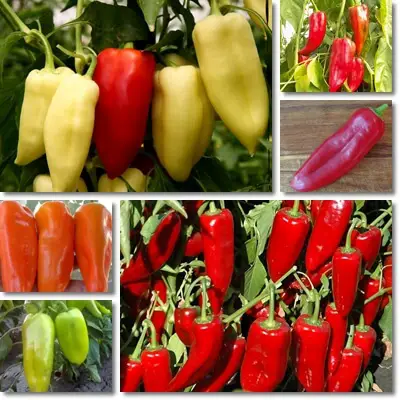Kapia peppers are the best roasting and frying peppers, but also a great source of nutrition. And you’ve probably had them at least once, just called them by a different name: Italian sweet peppers, Italian frying peppers, Corno di Torro or Bull’s Horn peppers. What are Kapia peppers good for? Eating Kapia peppers is good for weight loss, constipation, eyesight, skin health, blood pressure, blood sugar, energy metabolism and the immune system, among other benefits.
What do Kapia peppers look like?
The typical Kapia pepper is a fleshy, tapering pepper with a very defined tip. Popular varieties, like Elephant’s Ear Kapia, are larger and flattened laterally.
The skin is thin, smooth and glossy and peels easily off the roasted or fried pepper. The peppers themselves are quite meaty, with a tender, but succulent flesh with a strong, sweet, peppery flavor.
Kapia seeds are small, flattened and white, and have mild flavor.

The unripe peppers are deep green inside and out, and turn deep red and even orange and yellow when ripe. The most common color is, by far, the red Kapia, followed by unripe green Kapia and white Kapia which is, in fact, a lighter green Kapia pepper (same as white bell peppers).
What do Kapia peppers taste like?
A Kapia is a mildly sweet pepper type with no hotness or pungency to it. Its taste and flavor profile are similar to those of bell peppers, but the latter tend to be much stronger and better tasting overall. Ripe Kapia peppers, especially the red varieties, have the best taste: decidedly sweet, with strong sweet pepper flavor notes.
Unripe Kapia peppers may taste mildly sweet to somewhat bitter, depending on how unripe they are. Pale green Kapia peppers, also called white Kapia, are pleasant bitter flavor notes that pair great with any type of salad greens. The peppers are meaty, with a tender, crisp and succulent flesh and thin skin.
Kapia pepper nutrition
Kapia peppers have good nutritional value and are high in antioxidants. The raw peppers are an important source of vitamin C, with ripe peppers typically being higher in vitamin C than unripe ones. Kapia peppers are also a good source of vitamin K and several B group vitamins, notably vitamins B1, B3 and B6.
Red Kapia peppers are highest in pro-vitamin A antioxidants in the form of pigmented carotenoids (primarily beta-carotene, but also alpha-carotene and beta-cryptoxanthin), followed by orange Kapia. The unripe, green peppers have more chlorophyll instead.

Kapia peppers are low-calorie, with only 30-40 kilocalories per 100 g. They are also low-fat, low-protein, low-carb and low-sugar, as well as almost sodium-free. The peppers are a good source of dietary fiber and minerals such as manganese, potassium, magnesium, iron and phosphorus.
Kapia pepper seeds are a modest source of vitamin E and perfectly edible. A good reminder is that nutritional value varies in peppers as a result of growing conditions. Degree of ripeness, color and how you eat the peppers further impacts their nutrition.
For example: eating red and orange Kapia peppers fried in oil or with a source of fat on the side increases absorption of carotenoid antioxidants to serve as a source of vitamin A for the body. But eating Kapia peppers raw, preferably fresh, gets you vitamin C which boosts collagen production for antiaging benefits and benefits for faster wound healing.
16 Kapia peppers benefits
- Kapia peppers have mild laxative properties and are a good food to eat for constipation.
- Good for healthy weight loss due to being low in calories and fat.
- Source of potassium and magnesium and sodium-free, Kapia peppers are good for high blood pressure.
- Source of dietary fiber and low in fat, they provide minor benefits for blood cholesterol.
- Vitamin C in Kapia peppers helps maintain blood vessel elasticity through collagen synthesis and clear plaque from blood vessel walls.
- Antiaging benefits thanks to vitamin C which stimulates collagen synthesis for better skin elasticity and fewer wrinkles.
- Anti-inflammatory properties owed to a good content of vitamin C and pigmented and colorless antioxidants.
- Minor benefits for wound healing thanks to vitamin C, pro-vitamin A and B vitamins.
- Immune system boosting action in the form of free radical-scavenging, anti-inflammatory and wound healing benefits.
- Benefits for skin health: improved collagen synthesis for skin elasticity, production of new skin cells for skin renewal.
- Anti-anemia properties: Kapia peppers help combat anemia with iron and vitamins B1, B3 and B6.
- Kapia peppers boost energy levels and vitality with carbohydrates, sugars, B vitamins and iron.
- Good food to eat for tiredness and fatigue thanks to vitamin C which optimizes iron absorption and carbohydrates, iron and B vitamins which boost energy levels.
- Benefits for color vision, night vision and visual acuity owed to pro-vitamin A antioxidants in red and orange Kapia varieties.
- Benefits for blood sugar in diabetics: Kapia peppers are a low glycemic index food and don’t raise blood sugar levels too much too fast.
- Antioxidant benefits from vitamins A, C and E (in Kapia pepper seeds), chlorophyll (in unripe, green Kapia peppers) and other antioxidant polyphenols.
5 Kapia peppers side effects To Know
- Allergic reaction. Although rare, it is possible to be allergic to Kapia and other peppers.
- Acid reflux. Non-pungent capsaicinoid chemicals that give Kapia peppers their flavor can cause side effects such as acid reflux in some people. Discover more foods to avoid with acid reflux.
- Heartburn as a result of the regurgitation of stomach juices.
- Stomach upset with symptoms such as bloating, burping, burping that tastes metallic, acidic, sour or like pepper, abdominal cramps, loose stools and even diarrhea.
- Bad food to eat for gastritis. If you have gastritis, know that Kapia and other peppers, raw and cooked, can worsen symptoms and cause a flareup.
